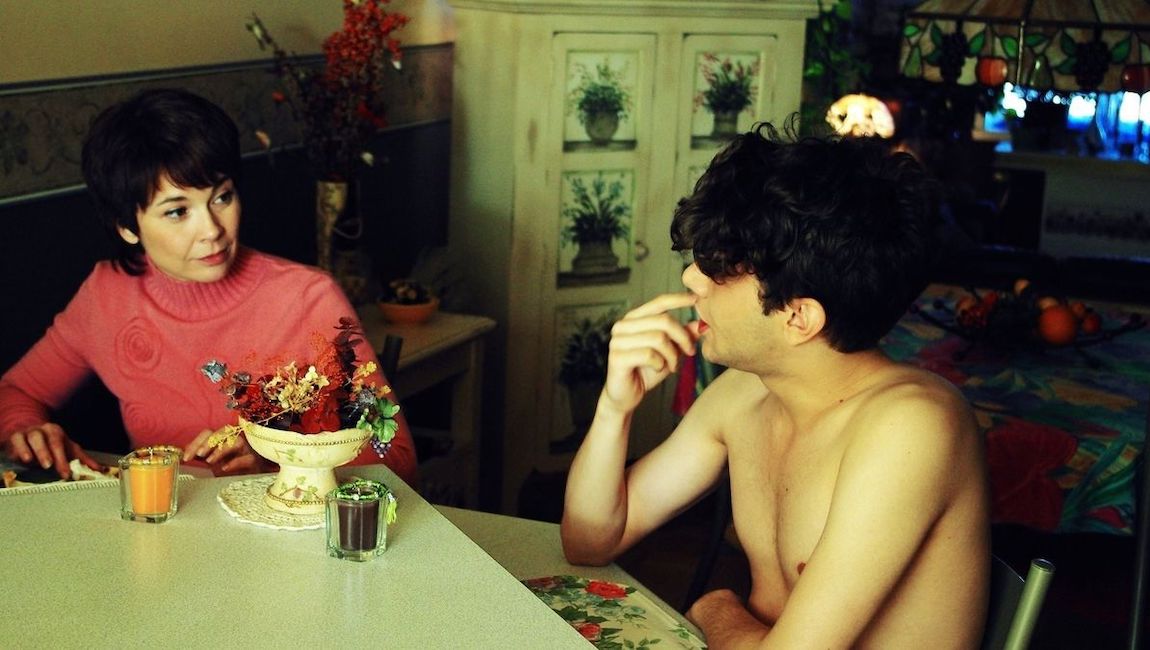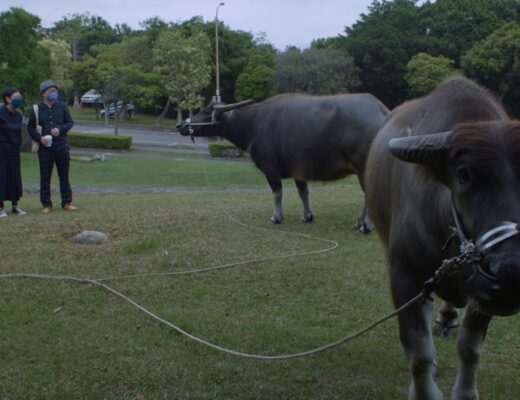Only the resentful or the contrarian could undervalue Xavier Dolan’s I Killed My Mother as an achievement both professional and cinematic. Written, produced, and directed by Dolan on the cusp of his twentieth birthday, the film would have fared half-decently with festival critics had he debuted his work at the age of 30. I Killed My Mother is a solid film in its own right, the more so because it transcends the over-homey kitsch that’s drecked up recent Quebecois cinema. It’s at once recognizable as a French-Canadian movie — in style and image, that is — and as the product of an autonomy determined to take new-century Quebecois film somewhere else entirely. It doesn’t completely do away with the kitsch — which is deployed only to be condemned — and it uses it in a more controlled manner than, say, Jean-Marc Vallée’s rather sticky C.R.A.Z.Y. Dolan’s debt to Kubrick, Kiarostami and Wong Kar-Wai (undoubtedly among his favorite auteurs) installs the kitsch in a cool and self-aware zone of detachment while retaining the warm bustle of Denys Arcand’s best “relationship” films. If Lauzon brought a gritty kind of Absurdism to our cinema in 1987 with Night-Zoo; if Lepage brought the brains and Villeneuve the dreaminess; and if Arcand commanded the most attention of all with his coy gab-fests, Dolan cherry-picks the ripest features from his predecessors and serves up a deep enough dish. Quebec has always been the playground of Canada’s best directors — with a few notable exceptions — and Dolan has earned his right to romp in it. Here lies not perfection, but promise.
Let the first-time director get the mimicry and homages out of his system now. Dolan undertakes his own artistic exorcism with I Killed My Mother, but his film isn’t mere juvenilia or rite-of-passage posing. Style, sure, is front and center, but it isn’t troublesome the way it can be in certain eager hands, and it’s even taken to task not just by the narrative itself, but by the way that narrative is framed by a spare, black-and-white interview that intercuts the larger, more colorful story: Dolan’s character, 16-year-old Hubert, complaining about his mother to his video camera in an empty room. The cinematic equivalent of a young painter’s self-portrait or a young photographer’s “feet” triptych, the on-camera confession is the truism that new filmmakers create as they test the resolve of their aesthetic vocation and hunt for a voice. Dolan the director is conscious of this, using his “interview” frame to expose the indulgence neat. His Hubert is indulgent, a self-absorbed and self-aggrandizing (read typical) 16-year-old in the throes of teen afflictions we wish on no one after enduring them ourselves. Hubert has to wrestle with the added irritation of a mother (Anne Dorval) who never outgrew her own adolescence, and of his homosexuality, which he’s accepted but which he’s kept from his parents and teachers. His father (Pierre Chagnon) is all but absent, and the only people he trusts are new love Antonin (François Arnaud) and new teacher Julie (Suzanne Clément), who wraps him in the maternal consolation he can’t find back home and nearly at the peril of her job.
It’s these small details — the fact that maternal-supplement Julie verges on self-sacrifice in order to provide a boy with a dollop of comfort — that elevate I Killed My Mother above standard-form relationship drama or experimental facsimile. Dolan privileges complexity. It’s evident in his toying with the matter of misogyny along with that of homophobia (always and forever linked) and the parent/child dyad, creating a sympathetic space for the women and men whom others expect too much, while at the same time condemning them for failing their intimates. He makes maternity (and, to a smaller degree, paternity) monstrous — a grotesque solipsism, a gaudy tiger — while he vexes our assumptions about it in all the right ways; Hubert may not be aware of his patriarchal indoctrination but Dolan is, because his cinematic palette avoids broad brushes in favor of slippage (both his own and Julie’s fathers dissatisfy, but neither is dressed in the incriminating metaphor literally worn by Hubert’s mom, or hung on her walls, or wrapped around her lampshades). The mother-beast he “kills” by disavowing her a dozen different ways really is a fractured guardian. Not just a being with abject taste in clothes and art, the suggestively named Chantale Lemming follows the prescribed paths of motherhood only so far: she irritates her son with her appliquéd sweaters but she also fucks with him — willfully or absent-mindedly, we’re never sure — the way a cat toys with a bird half-broken on the ground. She abandons Hubert on roadsides and goes back on promises — their copacetic moments are fewer and far between, while their bicker-fests pick up momentum.
Dolan stages their earliest argument in a car, which recalls the infamous opening of Kiarostami’s Ten in which a boy-child vomits disdain all over his mother as she drives him to one of his events. In Ten, the boy’s scorn is irrational and culturally formed; Hubert’s scorn is more understandable, more earned — it’s not just the raging of an entitled teen, or a youth’s contempt for social lemmings, or a queer’s contempt for breeders. More than any of these, Hubert’s heinous verbal assaults are the product of emotional abuse returned on his abuser tenfold. If Dolan borrows the confined tumult of a car drive from Kiarostami (using it more than once, and in pointed, allusive ways), he also reproduces Kubrick’s astonishing depth of field with the help of DP Stéphanie Anne Weber Biron. Shots are lavish but pristine, sometimes warm but most often clinical, which adds a fine dichotomy to the domestic scenes — to any scene in which Hubert wrangles with his mother or his mother’s stand-in, Julie. The scenes with Antonin or Antonin’s hipper, more affable mom are less colorful, even when the boys enjoy hot anal on a paint-spattered drop-cloth. From Kubrick Dolan also borrows the long tracking shot as a character marches up a line in slow motion, accompanied by resonant classical chords. These shots are as reminiscent of Wong’s In the Mood for Love as they are A Clockwork Orange (which also inspired a sped-up bedroom-vandalism scene in the third act); they’re emotive, sumptuous, crowd-pleasing and, yes, indulgent, but they’re lovely in replication and technically well-executed. I Killed My Mother is no student film.
Dolan may amuse himself with the signatures of other filmmakers, but he does so methodically. He plays here and there, but he relies most of all on a static camera placed directly before two or more characters like an unblinking eyeball — a technique that reproduces the relationship between camera and subject in a typical interview. We were instructed about the thematic importance of “interview” in the black-and-white frame story, and that theme is extended into the rest of the narrative as Hubert struggles to understand, to interrogate, to taxonomize the people around him. Dolan reinforces his “interview” conceit by resisting the urge to point his lens on photogenic Montreal or the even more photogenic Laurentians when Hubert is sent to a boarding school in Quebec’s Eastern Townships. His characters are rarely outside, and when they are, the outside is a narrow and impersonal outline. They mostly inhabit the laboratories of living rooms, dining rooms, classrooms, and offices — spots where interviews are more controlled, more commonly filmed. It’s a canny use of setting and blocking that doesn’t just add to the film’s glorious depth of field. It also points to what the movie says about relationship as mystery.
I Killed My Mother has grand ambitions which are mostly fulfilled. If there are leaden moments, they aren’t enough to sink it. Dolan does too well with story and technique, and he also does well with performance. As Hubert, he moves from a combustible state to a timid one, from presumption to tenuous optimism, in which his stricken brand of half-formed wisdom is visible not just in the lines of his face but in the droop of his shoulder. And he moves between these states almost always at the right instant. Anne Dorval makes it easy for us to sneer at her distracted mother, in order for us to feel what Hubert feels. But she’s also multidimensional under her salon tan — just human enough to inspire second guesses. She’s maternal and inattentive at once, sympathetic and negligible — maybe all too familiar, a presence we can’t dismiss any more than her son can. Other, more liminal characters move fluidly through their scenes, tender or hard with Hubert as the script demands, projecting with ease what it is that Hubert finds appealing or off-putting about them: the heat that golds the skin of the film’s real Antinoüs figure, Niels Schneider’s hood-eyed Éric; the bullying mass of his arrogant father, against which the form of his mother loses some of its toxicity. As the film concluded, the ending seems, at first glance, a little preemptive or stiff; on further reflection, Hubert’s and Chantale’s hand-holding as the screen goes dark in fact signals the bottom rest of an inexhaustible cycle. I Killed My Mother opens with discord and closes with concord, but everything we’ve seen in between suggests we’ve observed only a single loop in a coiling, tautological relationship. There’s never any resolution to enigmatic love affairs.







